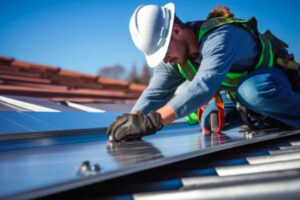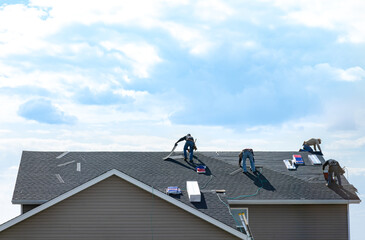As any homeowner knows, repairing your roof before it’s too late is a good idea. Otherwise, moisture can leak into your house and cause major problems.
However, deciding whether to repair or replace your roof involves several factors. Choosing the right option will depend on your current roof’s condition and budget.

A roof repair is usually less costly than replacing a roof, but it’s still a significant expense for homeowners. A few factors can impact the roof repair cost, including the material type, extent of damage, and location. These factors will influence whether it’s more cost-effective to repair or replace your roof, but you can also do a few things to minimize costs.
Leaking roofs can lead to expensive water damage. This can result in mold growth, warped wood, and structural issues in your home. It’s also important to address leaks quickly to prevent further damage and protect your roof’s integrity. It’s a good idea to inspect your roof regularly to catch any potential issues before they become serious problems.
The cost of repairing your roof will depend on the type and extent of damage. The price of materials will make up most of the repair cost, but labor will also play a role. Some roofing materials are more difficult to work with than others, and the pitch of your roof will affect how much labor is required. It’s also important to consider the age of your roof and how long you plan on living in your home when determining how much to budget for repairs.
Many homeowners may find that their roof repairs are covered by homeowner’s insurance, especially if the damages were caused by an insured peril such as a fallen tree or severe storm. However, homeowners should always check their specific policy to see what is and isn’t covered.
Some of the most common roof repairs include fixing cracked vents, leaking skylights, and cleaning gutters. These are often quick and easy DIY projects but can be more complex depending on the scope of the damage. Other repairs can be more expensive, such as replacing damaged shingles or repairing a hole in the roof. Hiring a professional is best to avoid costly damage for larger projects, such as repairing a dormer or installing a new skylight.
Regarding roof repair, many factors can impact the job’s length. For example, the severity of the issue and the contractor’s skills can affect how quickly the repair is completed. However, some general estimates can help homeowners gauge how long a repair may take.
For example, it’s generally agreed that a minor roof repair can take one to five hours to complete. This includes replacing shingles, fixing chimney flashing, and cleaning gutters. In contrast, larger jobs that repair leaks or sagging roofs can take multiple days to finish.
It’s also important to note that it’s best to complete roof repairs during dry weather. Rain, wind, and snow can add a lot of stress to the roof’s structure. Additionally, they can exacerbate existing damage and lead to additional problems.
Finally, if you have pets, it’s best to keep them indoors during roof repairs. Hammering and strangers can disturb them, exposing them to stray nails that could hurt them. It’s best to have them stay at a friend’s house or a boarding service during the repair process.
Keeping your roof in good condition is crucial to protecting your home’s interior and preserving its value. It’s a major structural component of your home, and it’s subjected to the elements daily. For this reason, it’s important to perform regular maintenance tasks, such as cleaning the gutters twice a year and inspecting flashings around chimneys and skylights annually for signs of wear and tear.
If you’ve never roofed before, then repairing your roof might seem like an impossible task. But you can prepare yourself by getting a comprehensive inspection done on your roof. It will help you understand what needs to be repaired and give you a good idea of what the job will involve.
I was inspecting the sheathing, shingle layers, ridge cap, and valley moldings for signs of leaks. Locate water entry points by spraying the roof with water and examining for evidence of moisture. I installed residential and commercial shingles, metal roofs, and PVC roofs. Set up scaffolding and inspected roofs to determine the best repair procedures.
Roofing requires a certain skill level; if you don’t have the right knowledge, you could suffer more damage than when you started. Experienced roofers will have a variety of tools at their disposal. These include a pry bar for removing and leveraging sheathing, flashing, drip edge, a hammer, and a nail puller. They’ll also have shears for neatly cutting shingles. It’s no secret that a roof is one of the most vulnerable areas of a home, and repairing it can be challenging. It takes a lot of patience and grit to get the job done well.
A roof warranty is a great way to protect yourself against the costs of roof repairs. However, it’s important to understand the different types of warranties and what they cover before purchasing a plan. There are two main types of warranties: artistry and manufacturer’s material. Both have their pros and cons. Artistry warranties typically only cover installation errors, while manufacturer’s material warranties usually include coverage of shingles and other materials.
It’s also important to read the fine print of any warranty you purchase. Manufacturers and contractors often stipulate their warranties to prevent consumers from taking advantage of the coverage. For example, they may require a contractor with certification from their company to perform repairs, or they may only provide coverage for certain parts of the roof (like shingles).
Another thing to consider is whether your warranty is prorated or not. A prorated warranty may only cover up to a certain percentage of the total repair cost. It’s best to choose a non-prorated warranty to get full coverage for your roof.
While it’s good to be able to conduct some home repairs yourself, you shouldn’t try to fix your roof on your own. Depending on your warranty, doing so could void its coverage. Many manufacturer warranties require the original roofing contractor to perform warranty services. Additionally, structural changes can also cancel a warranty. This includes re-roofing and installing things like satellite dishes or skylights.
If you have a warranty, be sure to register it. This will give the manufacturer a formal record of your product and ensure they have contact information for the contractor who installed it. You should also keep records of all maintenance and inspections on your roof. This will help you identify and fix small problems before they become more serious.
It’s important to remember that even the most durable roofing materials can damage or break down over time, especially if the climate is harsh. Keeping up with regular maintenance and inspections can help you spot minor problems and avoid expensive repair bills. For instance, you should clean leaves and debris from your roof regularly. Also, inspect your roof after major weather events or storms. In addition, it’s a good idea to remove moss and algae as soon as they appear.
Many homeowners need clarification on manufacturer warranties with artistry and material warranties. While these are similar in some ways, they differ in how they protect the homeowner. For example, a manufacturer’s material warranty will guarantee the materials for their typical lifespan but does not cover labor to replace or repair them. On the other hand, a roofer’s artistry warranty will protect the homeowner from any installation errors and is valid for a specific length of time.
Purchasing an extended warranty is a way to make your investment in a new roof last longer and to protect your home from unexpected repairs. However, you must be careful to read the fine print and ensure that you are working with a qualified contractor to provide the services you require. It is important to remember that specialist contractors are almost always more reliable and will provide you with a better warranty.


